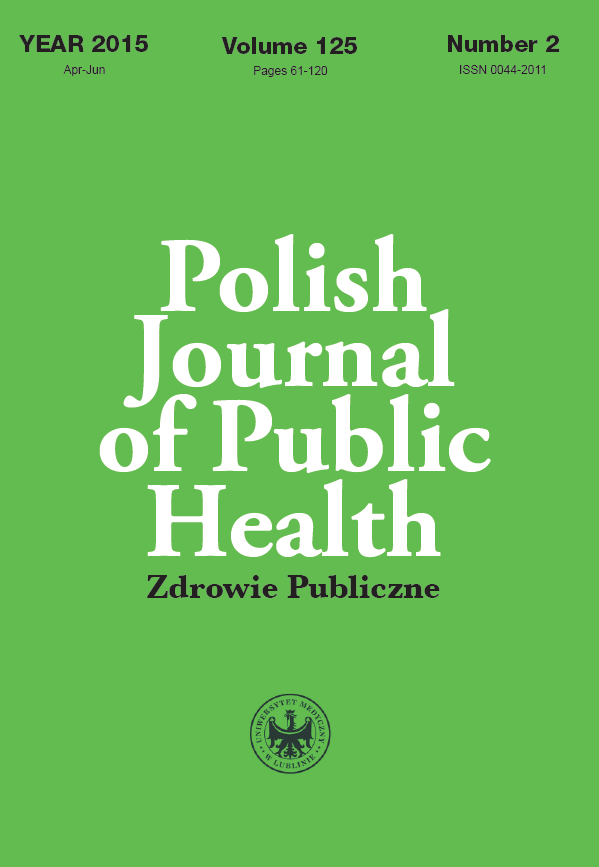Can CRP affect the blood-brain barrier during acute ischemic stroke?
DOI:
https://doi.org/10.1515/pjph-2015-0033Keywords:
CRP, ischemic stroke, S100BB protein, blood-brain barrierAbstract
Introduction. Ischemic strokes (IS) are one of the main causes of death and disabilities around the globe. Therefore, there is a huge need for researching the pathogenesis of IS. The C-reactive protein (CRP) plays a role during inflammatory processes. Results of some studies conducted on animal models indicate that CRP affects the blood-brain barrier (BBB) stability during IS. The presence of S100BB protein can be considered as an indication of BBB injury.
Aim. The purpose of this study was to discover the relationship between CRP and S100BB protein.
Material and methods. The study looked at fifty four IS patients, with the disease confirmed by computer tomography (CT). The clinical status was evaluated on the 1st, 3rd, 5th, 10th day and 3 months following the onset of IS. Neurological status was estimated using the National Institute of Health Stroke Scale (NIHSS). Patients’ disability level was determined, using Modified Rankin Scale (mRS) and Barthel Index (BI). The volume of ischemic focus was calculated on the 10th day after the stroke, using CT. The levels of CRP and S100BB were evaluated on 1st, 3rd, 5th and 10th day after the stroke onset with usage of ELISA method.
Results. The mean level of CRP and its concentration on the 1st, 3rd, 5th and 10th day directly correlates with a deteriorated clinical status, as measured with the use of NIHSS, BI and mRS on day 10 and 3 months after the onset of IS. We found a correlation with the mean CRP level and bigger volume of ischemic injury. The mean CRP level correlated with the mean level of S100BB protein. In the group of patients with low CRP (0.51-24.68 mg/mL) the level of S100BB and the volume of ischemic focus were lower than in the group with a high level of CRP (24.69-209 mg/mL).
Conclusions. CRP can be considered as a predictor of a worse clinical outcome after stroke. The relationship between CRP and S100BB protein can suggest the active role of CRP during IS.
References
1. Black S, Kusher I, Samols D. C-reactive Protein. J Biol Chem. 2004;279:48487.
2. Thompson D, Pepys MB, Wood SP. The physiological structure of hu¬man C-reactive protein and its complex with phosphocholine. Structure. 1999;7:169-77.
3. Elkind MS. Inflammatory mechanisms of stroke. Stroke. 2010;41(Sup¬pl. 10):S3-8.
4. Genest J. C-reactive protein: risk factor, biomarker and/or therapeutic target? Can J cardiol. 2010;26(Suppl. A):41A-44A.
5. Muir KW, Weir CJ, Alwan W, et al. C-reactive protein and outcome after ischemic stroke. Stroke. 1999;30:981-5.
6. Welsh P, Barber M, Langhorne P, et al. Associations of inflammatory and haemostatic biomarkers with poor outcome in acute ischaemic stroke. Cerebrovasc Dis. 2009;27:247-53.
7. Shantikumar S, Grant PJ, Catto A, et al. Elevated C-reactive protein and long-term mortality after ischaemic stroke: relationship with mark¬ers of endothelial cell and platelet activation. Stroke. 2009;40:977.
8. Arenillas JF, Alvarez-Sabin J, Molina CA, et al. C-reactive protein predicts further ischemic events in first-ever transient ischemic attack or stroke patients with intracranial large-artery occlusive disease. Stroke. 2003;34:2463-8.
9. Ormstad H, Aass HCD, Lund-Sorensen N, et al. Serum levels of cy¬tokines and C-reactive protein in acute ischemic stroke patients, and their relationship to stroke lateralization, type, and infarct volume. J Neurol. 2011;258:677-85.
10. Grad E, Pachino RM, Danenberg HD. Endothelial C-reactive protein increases platelel adhesion under flow conditions. Am J Physiol Heart Circ Physiol. 2011;301:H730-6.
11. Kuhlmann CR, Librizzi L, Closhen D, et al. Mechanisms of C-reactive protein-induced blood-brain barrier disruption. Stroke. 2009;40:1458-66.
12. Pepys MB, Hischfield GM, Tennent GA, et al. Targeting C-reactive pro¬tein for treatment of cardiovascular disease. Nature. 2006;440:1217-21.
13. Gill R, Kemp JA, Sabin C, Pepys MB. Human C-reactive protein increases cerebral infarct size after middle cerebral artery occlusion in adult rats. J Cereb Blood Flow Metab. 2004;24:1214-8.
14. Sen J, Belli A. S100B in neuropathologic states: the CRP of the brain? J Neurosci Res. 2007;85:1373-80.
15. Wang M, Etu J, Joshi S. Enhanced disruption of the blood brain barrier by intracarotid mannitol injection during transient cerebral hypoperfu¬sion in rabbits. J Neurosurg Anesthesiol. 2007;19:249-56.
16. Kleindienst A, Ross Bullock M. A critical analysis of the role of the neurotrophic protein S100B in acute brain injury. J Neurotrauma. 2006;23:1185-200.
Downloads
Published
Issue
Section
License
Copyright (c) 2015 Polish Journal of Public Health

This work is licensed under a Creative Commons Attribution-NonCommercial-NoDerivatives 3.0 Unported License.


